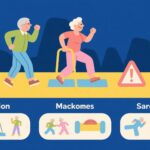Background
Physical exercise is a cornerstone of maintaining health and vitality, particularly for seniors striving to live active and independent lives. However, not all exercise routines are beneficial; some can inadvertently cause harm rather than promote well-being. This article examines common misconceptions and errors in senior exercise practices and provides evidence-based guidance for safe and effective physical activity.
Scientific and Clinical Evidence: What the Data Tell Us
Research underscores the importance of tailored exercise regimens for seniors. According to the Centers for Disease Control and Prevention (CDC), regular physical activity can reduce the risk of chronic diseases, improve balance and coordination, and enhance mental health. However, studies also highlight the risks associated with improper exercise, such as joint damage, cardiovascular strain, and poor recovery from injuries.
Misconceptions and Harmful Behaviors
Many seniors unknowingly engage in activities that may be detrimental to their health. Common errors include prolonged periods of intense dancing, overly vigorous shoulder exercises, and inappropriate core workouts. For example:
– **Excessive Dancing**: Extended sessions of high-impact activities like dancing can accelerate joint wear, particularly in the knees.
– **Improper Shoulder Movements**: Exercises involving repeated overhead motions can exacerbate conditions like rotator cuff injuries.
– **Strenuous Abdominal Exercises**: Movements such as sit-ups can strain the spine and aggravate existing conditions.
Correct Health Practices and Practical Tips
To ensure safety, seniors should adhere to modified and balanced exercise routines:
– **Joint-Friendly Activities**: Opt for low-impact exercises like swimming or tai chi to reduce joint strain.
– **Controlled Movements**: Incorporate stretching and strengthening exercises that maintain a comfortable range of motion.
– **Gradual Intensity Increase**: Build up endurance gradually to prevent overexertion and injury.
Expert Recommendations and Insights
Healthcare professionals recommend focusing on consistency and moderation rather than intensity. Dr. Amanda Lewis, a geriatric exercise specialist, advises, “Seniors should prioritize exercises that enhance mobility and balance while avoiding those that place undue stress on vulnerable areas like the knees, shoulders, and spine.”
Patient Scenario
Consider Susan, a 67-year-old retiree who began daily stair climbing as part of her fitness routine. Despite initial enthusiasm, she experienced knee pain and swelling. Upon consulting a physiotherapist, Susan learned that repetitive stair climbing was exacerbating her pre-existing arthritis. Switching to water aerobics significantly improved her symptoms.
Conclusion
Exercise remains vital for senior health, but it must be approached thoughtfully to prevent injuries. By understanding common pitfalls and embracing safer practices, seniors can enjoy the benefits of physical activity while minimizing risks.
References
1. Centers for Disease Control and Prevention. “Physical Activity for Older Adults.” CDC.gov.
2. American Council on Exercise. “Exercise Guidelines for Seniors.” ACEfitness.org.
3. National Institute on Aging. “Safe Exercises for Seniors.” NIA.gov.



